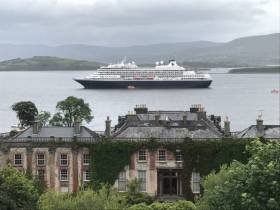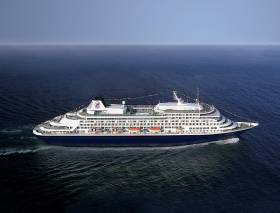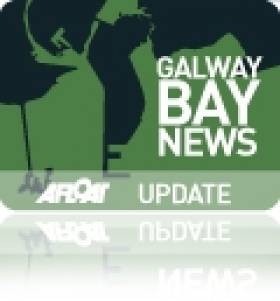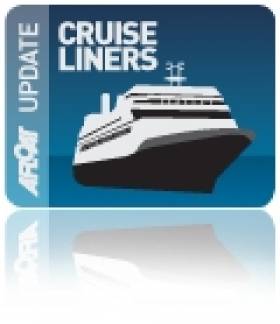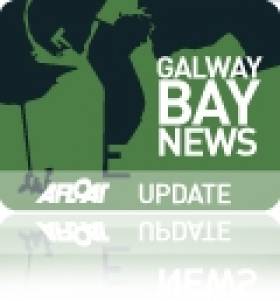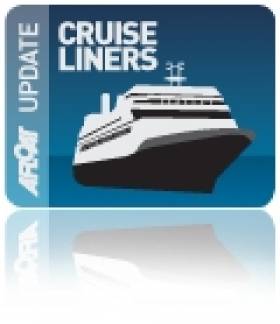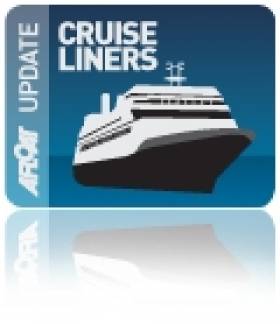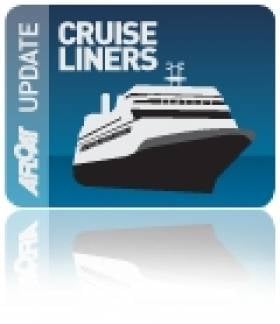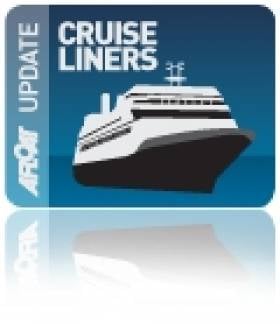Displaying items by tag: Holland America Line
A Holland America Line cruise ship has become the largest to visit the Isle of Man having anchored in Douglas Bay this morning with over 2,000 American passengers on board.
The 99,500 gross tonnage cruise ship Nieuw Statendam had sailed overnight from Dublin Bay having anchored off Dun Laoghaire Harbour yesterday.
Nieuw Statendam is the second of the 'Pinnacle' class ships, which celebrates historic New York City with an inspired design and art collection. In addition the design draws inspiration from the elegant curves of musical instruments. Among the musical themes facilities is the B.B. King’s Blues Club.
The 2018 built cruise ship has become the 23rd cruise ship to visit Manx shores so far this year, as a further 31 callers are scheduled.
During their time, the visitors, most of them from the U.S., will be able to choose from a range of tours throughout the Isle of Man, among them excursions organised is the Story of Mann held in the House of Mannin, to Snaefell mountain and the coastal town of Peel.
Deborah Heather from Visit Isle of Man says there's keen interest in the Island's heritage, and passengers provide a significant financial boost to the local economy, to listen Manx Radio also has an audio link.
Port Company Welcomes First Liner to Bantry In 30 Years
#BantryBay - MS Prinsendam of Holland America Line made her maiden call to Bantry Bay Harbour writes West Cork Times on what was to be the first visit of a cruise liner to Bantry in almost 30 years.
Carrying more than 800 passengers, MS Prinsendam arrived in the early hours of the morning and will stay until evening ensuring their passengers get every opportunity to explore the region.
Speaking about the arrival of MS Prinsendam to Bantry, Bantry Bay Port Company Harbour Master Captain Paul O’Regan said, “We are very encouraged by Holland American Lines commitment to call to Bantry. This is an exciting time for the whole of West Cork as we aim to grow this cruise business considerably over the next few years.
“We have the experience and professionalism within the Port of Cork of what needs to be achieved to grow the cruise business here, and Bantry Bay Port Company is fully committed. The unique selling point with Bantry is to attract the smaller boutique cruises or expedition cruises which can access smaller ports and harbour, meaning their passengers can benefit from a richer experience onshore.”
For more on this story click here.
HAL Visits Belfast On Celtic & Bourgundian Explorer Cruise
#HALcall – Holland America Line’s Prinsendam berthed in Belfast Harbour this morning as part of a 28 Day Celtic & Bourgundian Explorer Cruise, writes Jehan Ashmore.
This was the second call of HAL's Prinsendam to Belfast this season as she called in July. Overall, this morning's call was her 14th visit to the port having berthed at the Stormont cruise wharf. She has a capacity for more than 766 passengers and 460 crew.
Prinsendam at under 40,000 gross tonnage is the smallest of the HAL fleet which now has a newcomer, Koningdam, just shy of 100,000 gross tonnage. She was named in May as the first of the 'Pinnacle' class, the largest ever built for the US based operator, part of the Carnival Corporation. The newbuild can take a maximum of 3,200 passengers and over 1,000 crew.
Today’s call of Prinsendam represents the 29 caller and last of this month alone to Belfast. Asides, HAL, among the cruise operators they include Princess, Celebrity, Cunard, Silversea, Majestic, and Fred Olsen.
The port is to host almost 145,000 cruise visitors this season as the harbour is the principle gateway to the attractions of city and Northern Ireland.
Prinsendam had set off from Dublin, where she overnighted at Ocean Pier, within Alexandra Basin, where another fleetmate, Rotterdam had called earlier this month.
#HALtenderLINKS - Having anchored off Galway Harbour today, Holland America Line's 800 passenger Prinsendam and her fleet of tenders leave in their wake strong ties with the mid-west port, writes Jehan Ashmore.
At 38,848 tonnes, Prinsendam is the smallest member of the HAL fleet and having started off as Royal Viking Sun as the final ship launched for her original owners Norwegian Viking Line. Since last weekend she has been cruising Irish ports, firstly Dublin and yesterday Killybegs.
As previously reported on Afloat.ie, HAL have a history of regular liner trans-Atlantic calls to Galway Bay. During the careers of their Maasdam and Ryndam this required the use of a dedicated liner tender based in the port, the former Calshot which HAL purchased in 1964 through a subsidiary, Port & Liner Services (Ireland) Ltd.
This saw the 500 plus passenger tender converted from steam to diesel power and renamed Galway Bay. Her classic funnel was also altered and she was repainted in HAL colours during this period as she plied passengers between the liners and Galway Pier.
Also during her Irish career the 700 tonnes tender was chartered to CIE to serve the Aran Islands in the role of a ferry directly from Galway City dock and with a capacity reduced of 400.
She would serve HAL until sold in 1971 to Galway Bay Ferries again continuing the routes between the city to Kilronan, the capital of Inishmore and neighbouring islands of Inishmaan and Inisheer.
Prior to her west of Ireland days, she also served the trans-Atlantic liners in and out of Southampton, having been launched as the Calshot in 1929 at Vosper Thornycroft, Woolston yard for Southampton based Isle of Wight & South of England Royal Mail Steam Packet Company or Red Funnel as it became known.
Her Solent days saw her alongside the famous Cunarder liners Queen Mary and Queen Elizabeth. She also took part in a D-Day role as a headquarter ship at Juno Beach.
Afloat.ie will have more about the Galway Bay which in 1986 returned to original home waters of Southampton in 1986 for preservation and restoration by her current owners, The Tug Tender Calshot Trust.
#CruiseLiners – Galway Harbour Company will welcome the fifth cruise caller this season when Holland America Line's Prinsendam calls this day next week, writes Jehan Ashmore.
As previously reported, this season is one of the busiest in recent years for the mid-west port when eight calls are made and all by different operators. Due to their size, all cruiseships are to anchor offshore in Galway Bay.
The mid-sized cruiseship at 37,000 tonnes is capable of carrying more than 800 passengers and she follows a history of HAL calling to Galway when regular liner calls in 1939 reached 56 that year.
According to the port's website's cruiseliner list, the following other calls are by Crystal Cruises, Phoenix-Reisen and Club Med until the close of season in early September.
Cruiseship Galway Bay Anchorage Call, Larger Ships In Future?
#GalwayHarbour- Prior to Prinsendam's next port of call to Foynes tomorrow, as previously reported, the Dutch flagged cruiseship is today at anchorage off Galway Harbour, writes Jehan Ashmore.
The Holland America Line 38,848grt ship is nearly 1.5 nautical miles offshore in Galway Bay, facing opposite the entrance to Galway Harbour's only single basin, the Dun Aengus Dock.
As reported earlier in the summer, there are plans to build a new larger harbour. Notably, the new outer port would be capable of handling even larger cruiseships than the current anchorage callers. In addition the port wants to bring back the transatlantic callers, reminiscent of the liner era.
This year's Galway Harbour cruise season was opened by the arrival in July of the ultra-luxury and exclusively residential-only vessel, The World which had made an overnight call.
The mid-western port subsequently welcomed the newly launched Le Soreal, the mega-superyacht like cruiseship with a 264-passenger capacity is operated by Companie du Ponant.
Le Soreal is the latest of the three newbuild sisters, L'Austral and Le Boreal which in 2011 visited Dublin Port.
Marking the final cruise caller for the season is Explorer which is due in September. Already lined up so far for the 2014 season is the return of Prinsendam and Crystal Symphony.
#HollandAmerica – Dunmore East is to host three Holland America Line (HAL) cruiseships of varying sizes this season which runs until mid-September, writes Jehan Ashmore.
The largest of the trio Eurodam (86,273grt) had visited today with an anchorage call and she is to be followed by a pair of fleetmates next month. The twin funnelled vessel is cruising from Alesund in Norway to Amsterdam with a passenger capacity potential of 2,104 passengers and a crew of 929.
Next to call on 2 August is Veendam (56,982grt) also from Amsterdam and heading for Bergin with her 1,350 passenger capacity and 580 crew. She is named after the capital of the Netherlands's northern peat colonies.
Making the final member of this trio is a call on 14 August by Prinsendam (37,845grt), which is the smallest of HAL's 15-strong cruiseship fleet.
She originally began her career as Royal Viking Line's white hulled Royal Viking Sun, and she is to sail from Reykjavik to Amsterdam with her designed capacity of 766 passengers and 460 crew.
Combined these calls bring a welcome boost to the Waterford estuary region with benefits to key tourist attractions, among them the House of Waterford Crystal.
Across the estuary is the Hook Lighthouse & Heritage Centre which as previously reported is where the Gathering of Lighthouse Keepers is to be held on the Hook Peninsula in September.
Cunard Line's Newest Cruiseship to Revisit
#CUNARDER REVISIT – Since her launch in 2010, Cunard Line's newest cruiseship the 90,901 tonnes Queen Elizabeth has only called to Dublin Port once and that was last year. She was then on her maiden 'Irish' port of call and the 2068 passenger vessel is to return on Saturday, writes Jehan Ashmore.

Joining her on the schedule of visiting cruiseships this August, which not surprisingly is the busiest period of the high-season, will be Holland America Line's Maasdam. She is to arrive only an hour later that morning.
The month is scheduled to see 28 cruise callers (list) in total, the first caller having already arrived yesterday with the Hebridean Princess staying overnight in the port.
Following the Cunarder's call she will her head overnight bound for Cobh Cruise Terminal, where the Italian built vessel also made an inaugural port of call (list) in 2011.
Cruiseship Boost for Belfast
#CRUISE LINERS-Belfast Harbour looks forward to another bumper year as cruise operators are to increase by 32% compared to last year, with 41 cruise ships bringing almost 75,000 visitors to the port.
The following major operators are to visit: Cruise & Maritime Voyages, Fred Olsen Cruise Lines, Holland America Line, Princess Cruises and Saga Cruise and others will dock from far flung destinations.
At over 1km long, Stormont Wharf, will again be the main berth for cruiseships in particular the ability to accommodate an increasing trend in larger class vessels touring the Irish Sea. The wharf was extended in recent years at a cost of £10m and is the longest deepwater quay in Ireland.
To promote Belfast Harbour as a cruiseship destination, the port and the Belfast Visitor and Convention Bureau (BVCB) set up the Cruise Belfast Initiative to market the location internationally.
For further information visit www.cruise-belfast.co.uk and to view the seasons schedule of cruise callers click HERE.
Three Masterpieces Set to Make an Impression in Dublin
Arcadia caters for the UK market and she is on a 13-night cruise which so far has included calls to North Shields, Tyneside, Invergordon, Shetland Isles, Glasgow, Belfast and Liverpool. After her call to the capital she heads for Cork and finally to St Peter Port, Guernsey.
Readers may note that the vessel is of the same design as of Cunard Line's Queen Victoria, which also called to Dublin in May and Cork. In fact Arcadia was to be given the regal name but the 2005 Italian built vessel was transferred from Cunard Line to P&O Cruises, which are under control of US-owned cruise giant Carnival Corporation.
Notable external features of the Arcadia are glass-fronted lifts, two pools, one with a skydome and an interior that is brimming with an art collection consisting of over 3,000 works. She has many facilities such as a three-tier palladium theatre, an intimate 30-seater cinema and gymnasium with an ocean view to inspire those exercising at sea. She was constructed in just twenty months by the Fincantieri shipyard, just outside Venice.
Likewise Eurodam has an extensive art collection theme that is based on the Dutch master's 'Golden Age' including "The Nightwatch, Two Minutes Later", a contemporary re-interpretation of Rembrandt's famous painting. In addition there are 17th-century watercolour maps by famed cartographer Johannes Vingboons.
Passengers on the 11-decked Signature-class can also enjoy the Pan-Asian restaurant and lounge surrounded by panoramic views, an explorer's lounge bar, an Italian restaurant adjacent to the lido, jewellery boutique, atrium bar, show lounge and a photographic and imaging-centre.
Last but not least to dock around lunchtime will be the 30,000 tonnes Ocean Princess, operated by Princess Cruises, another subsidiary of the Carnival Corporation. The 680-passenger / 181 m long vessel may be the smallest of tomorrow's callers and within the Princess Cruises fleet, but the former Tahitian Princess, which underwent an extensive dry-docking in Singapore last winter is well equipped with facilities.
She has a cabaret lounge, club restaurant and bar, casino bar, main pool and spa, steakhouse restaurant, panorama buffet, an Italian restaurant and the Tahitian Lounge. To see the work conducted at the dry-dock, you can view a slideshow by clicking HERE and to see the work in a completed state which also applied to her sister Pacific Princess, watch this VIDEO.
- Dublin Port
- port of Cork
- Dublin Bay News
- Princess Cruises
- P&O Cruises
- Cruiseships
- Port of Dublin
- Ports and Shipping News
- Cunard Line
- Dublin Port news
- Holland America Line
- queen victoria
- Fincantieri Shipyard
- Port of Dublin news
- Arcadia
- Eurodam
- Ocean Princess
- Irish cruiseship ports ofcall
- Dutch masters
- Rembrandt
- Onboard Art Collection
- Johannes Vingboons



























